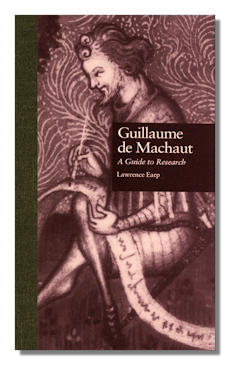
The Internet's Premier Classical Music Source
Related Links
-
Introduction
Acoustics
Ballet
Biographies
Chamber Music
Composers & Composition
Conducting
Criticism & Commentary
Discographies & CD Guides
Fiction
History
Humor
Illustrations & Photos
Instrumental
Lieder
Music Appreciation
Music Education
Music Industry
Music and the Mind
Opera
Orchestration
Reference Works
Scores
Thematic Indices
Theory & Analysis
Vocal Technique
Search Amazon
Recommended Links
Site News
 Book Review
Book Review
Guillaume de Machaut

A Guide to Research
Lawrence Earp
Garland Press. 1995. xix + 669
ISBN-10: 0824023234
ISBN-13: 978-0824023232
The Garland Composer Resource Manuals (under the general editorship of Guy Marco and the imprint of Routledge) have established themselves as often the definitive accumulations of factual, biographical, bibliographical and where possible and/or appropriate of discographical information about a dozen or so composers. Lawrence Earp's Guillaume de Machaut: A Guide to Research is decidedly in that mold. It represents in a single volume as near as definitive a body of information, data, facts, chronologies, background, manuscript and provenance details, biography, scholarly research and relevant analysis as is to be had anywhere.
That's just as well for the substance of the book is well over 600 pages in length. On top of that there are three indexes: General (14 pages), of manuscripts (4 pages), and of works (28 pages). Near Earp's concise and informative scene-setting preface come four pages of meticulously cross-referenced abbreviations, and a list of the 25 tables in the book.
Casually to skim Guillaume de Machaut: A Guide to Research is almost to be taken aback with the density and volume of its factual data. This is not a narrative, though presumably it could be read sequentially; but a comprehensive hoard of information about the life and work of arguably the greatest composer of the fourteenth century, Guillaume de Machaut (c.1300-1377). And its thoroughness, completeness and accessibility make it a very desirable resource for "early" music lovers in general and aficionados of Machaut in particular.
Guillaume de Machaut: A Guide to Research is divided into eight substantive sections: a biography (12% of the book's text); a discussion of Machaut's musical and literary legacies (4%); the manuscripts (12%); the Miniatures (13%); the Dits (11%); the lyrical poetry (8%); the music's chronology (27%); and a discography – apparently updated and amazingly well annotated, but by no means current (13%).
The sheer quantity of information contained in this book may seem at first off-putting. Certainly you're likely to make use of the fact that it's well bound as you refer back and forth between index, interpretation of abbreviations and cross references among works, biography and manuscript. Once you become familiar with the book's very open and easily understood conventions, though, the amount of data becomes its strength. And despite not being a conventional study of Machaut, nor a collection of essays like the excellent Machaut's Music: New Interpretations (reviewed here in June 2009), still less a simple composer biography, and much more than a "Companion" (although that's the type of book to which Guillaume de Machaut: A Guide to Research comes closest), characteristics, feelings and the most important pre-occupations and concerns of the composer do emerge by virtue of the fact that you are dealing in and with his world and works so intensely. What's more, medievalists specializing in other aspects of this most turbulent of centuries with interests in the history, chronicling and literature (by Machaut himself and his contemporaries) will find much relevant and useful material here for them too.
The physical layout of the book is perhaps a tiny bit on the cramped size… the page size is under 6" x 9". But the use of white space is generally intelligent and conducive to using the book's contents. There are no plates or illustrations as such. But the quality of the index, annotation, footnoting and bibliographical and referencing conventions are just what's needed instead. Given the density and complexity of the text, the typographical systems used quickly make accessing the book's material easy and straightforward.
It's true that the book is aimed at (graduate) research. Yet to follow a lead in a (perhaps incomplete) liner note, to look up a reference, identify a work, to source critical comment and to pursue thematic analysis of every note Machaut wrote – indeed, to separate the correctly from the incorrectly attributed works of the composer – this is the single most authoritative, accessible, comprehensive and usable source on Machaut in existence and as such can be thoroughly recommended. The internet has more current information, obviously. But nothing approaches this book in every other way.
Copyright © 2009 by Mark Sealey


















